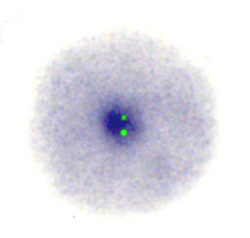MBL Scientists Find Evidence of RNA in Organelle Essential to Cell Division

Clam centrosomes (center in green) encased in RNA (blue) provide strong evidence that the RNA is closely associated with these organelles. Image by Mary Anne Alliegro.
Despite more than a century of study, scientists know relatively little about the inner workings of centrosomes–organelles essential to cell division in humans and animals. Now new research by scientists studying surf clams at the MBL (Marine Biological Laboratory) shows that centrosomes may contain ribonucleic acid (RNA), the molecule that translates genes into proteins.
The research, published June 5 in the online early edition of the Proceedings of the National Academy of Sciences, suggests that centrosomes may carry at least some of their own genetic machinery and offers new opportunities to answer long-held questions about centrosome function, heredity, and evolution. The article will also be published in the journal’s June 13 print edition.
Centrosomes play a key role in cell division. When the process begins, a single centrosome copies itself and the two organelles migrate to the cell’s edges, where they help tease apart the chromosomes, and assure genetic stability from cell to cell. In fact, centrosome instabilities have been linked to tumor malignancies, so answering basic questions about how these organelles work may ultimately aid cancer research.
The clam centrosome study, led by MBL summer investigator Mark Alliegro of Louisiana State University Health Sciences Center (LSUHSC), in collaboration with Mary Anne Alliegro of LSUHSC and Robert Palazzo, of Rensselaer Polytechnic Institute, detected five RNA sequences in clam eggs that appear to be unique to the centrosome. “The implications are broad and I expect there will be lively discussion on their meaning for topics from cell division to eukaryotic evolution. At this point we know very little about their function or origins, but we are confident they represent a special set of transcripts,” says Dr. Mark Alliegro.
The findings are likely to spark debate among biologists who have contemplated how these organelles self replicate. Although the consensus is that centrosomes lack DNA, the question of whether they contain RNA has never been adequately answered. “The RNA question has always been controversial, but we couldn’t close the door on it,” says Dr. Palazzo. “This is the first really good evidence that nucleic acid co-purifies with the centrosome, which means it is physically present.”
The centrosome study was initiated at the MBL, an international biological research center, where many scientists use locally abundant marine organisms like surf clams ( Spisula solidissima ) and their eggs as research models. Clam eggs are simple versions of human cells, and biologists who study cell division value them for several reasons. They develop fast, entering meiosis within less than a quarter hour after fertilization, and, once fertilized, divide synchronously every 30-50 minutes – providing billions of biochemically identical cells to study.
Using a technique Dr. Palazzo developed at the MBL, the scientists were able to isolate relatively large quantities of clam centrosomes. Skills developed in Dr. Alliegro’s laboratory were then used to extract a unique set of RNAs and demonstrate their association with centrosomes biochemically and in situ .
“The next step will be to determine what role these RNAs might play in centrosome replication, the cell cycle, or the development of organisms,” Dr. Alliegro says. Meanwhile, the scientists hope their paper serves to alert researchers working in other model systems that centrosomal RNA might exist and that it could be playing an important role in life processes.
Media Contact
More Information:
http://www.mbl.eduAll latest news from the category: Life Sciences and Chemistry
Articles and reports from the Life Sciences and chemistry area deal with applied and basic research into modern biology, chemistry and human medicine.
Valuable information can be found on a range of life sciences fields including bacteriology, biochemistry, bionics, bioinformatics, biophysics, biotechnology, genetics, geobotany, human biology, marine biology, microbiology, molecular biology, cellular biology, zoology, bioinorganic chemistry, microchemistry and environmental chemistry.
Newest articles

Properties of new materials for microchips
… can now be measured well. Reseachers of Delft University of Technology demonstrated measuring performance properties of ultrathin silicon membranes. Making ever smaller and more powerful chips requires new ultrathin…

Floating solar’s potential
… to support sustainable development by addressing climate, water, and energy goals holistically. A new study published this week in Nature Energy raises the potential for floating solar photovoltaics (FPV)…

Skyrmions move at record speeds
… a step towards the computing of the future. An international research team led by scientists from the CNRS1 has discovered that the magnetic nanobubbles2 known as skyrmions can be…





















